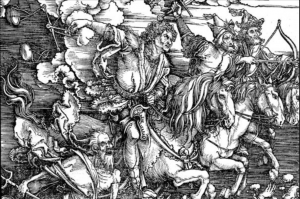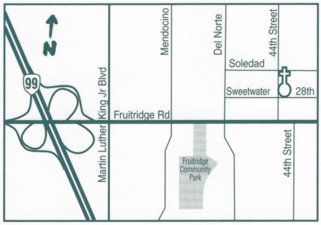From the Vicar
October 7, 2018
Fr. Savoie: New Series on the Office of the Dead
The cataclysms of the fourteenth centuries shook Christendom to its core. The trauma was destined to change the physical church and the society in which she was centered. With the passing of the stable social structures, from the apparent stability of the papacy, tranquility of the state, material sustenance and preservation of life, one would expect ruins. The edifice of society was truly crumbling; but rather than destroying the Church, the wounds revealed her heart.
Lay devotion was altered and attuned itself to the new circumstances. With the end of everything befalling them the laity didn’t simply shun the void, they considered it. In the face of uncertainty, they firmly rested on what was certain; all things have an end. They lifted their thoughts to their heavenly final-end, the end of the world and their own personal end—death.
LECTURE ONE
The Four Horsemen and the Office of the Dead meet in the 14th Century

October 18th, 6:30 Mass, 7:15 Cocktail Social, 8:00 Lecture
June 17, 2018
Dear parishioners,
After my sermon last week there were some requests for a written reminder of the various signs by which we might have moral certainty of our salvation.
Here they are:
-
1 A good life
2 The testimony of a good conscience
3 Patience in adversities for love of God
4 Relish for the light and the word of God
5 Mercy toward those who suffer
6 Love of enemies
7 Humility
8 Special devotion to the Blessed Virgin Mary
This list is taken from the work of Fr. Reginald Garrigou-Lagrange, probably the greatest theologian of the twentieth century and one of the great Thomists of all time. Immediately after the eight signs listed, he adds the following, “Theologians sometimes add these special signs: first, a great intimacy with God in prayer; secondly, perfect mortification of the passions; thirdly, the ardent desire to suffer much for the glory of Christ Jesus; fourthly, an indefatigable zeal for souls.”
In our own time we should also call special attention to the practice of the nine First Fridays and five First Saturdays.
In the context of the above passage, Fr. Garrigou-Lagrange also notes this: “One elect soul is a spiritual universe.” As we know, grace elevates human nature
above the entire natural order; St. Augustine writes, “God became man, in order that man might become God.” Considering the gift of sanctifying grace, a
participation in the divine nature itself, St. Leo the Great admonished the Church: “Christians, remember your dignity.”
Let us sacrifice whatever is necessary on the altar of this unimaginable gift.
God bless you,
Fr. Curtis
June 10, 2018
Dear parishioners,
I’m happy to announce the establishment of two new apostolates in the North American District of the FSSP. They will both be opening in the late summer after the closing of the General Chapter.
The first of these is St. Mary’s Catholic Church in Conshohocken in the Archdiocese of Philadelphia, Pennsylvania. It is a beautiful Church on the northwest outskirts of Philadelphia itself. The Archdiocese is under the care of His Excellency, the Most Reverend Charles Chaput. The Archbishop also brought us into Denver during his time there.
The second is St. Mary’s Catholic Church in Providence, Rhode Island. This gothic Church, built in the mid-nineteenth century, is very near eastern Connecticut, southern Massachusetts, and the metropolitan Boston area. His Excellency, the Most Reverend Thomas Tobin also has a history of great generosity with the Priestly Fraternity; in 1997 he gave us a parish in Youngstown, Ohio, where he was serving as bishop at the time. The
Bishop is erecting St. Mary’s as a personal parish under the care of the FSSP.
Both of these apostolates are representative of a very recent development in the North American District, namely, our push into the northeastern region of the United States. After decades of waiting, we finally opened up in New Hampshire two years ago in 2016. Then only a year later we opened in Baltimore.
Please continue to pray for new opportunities for our priestly society and all traditional societies struggling to advance the Latin Mass into regions where people have been waiting for it, sometimes for many long years. Pray also for priestly vocations, and for our priests.
God bless you,
Fr. Curtis
June 3, 2018
Dear parishioners,
As many of you are aware, last weekend the Priestly Fraternity of Saint Peter ordained ten men to the priesthood in Omaha, Nebraska. Below are the names of the men ordained. Please pray for them.
-
Fr. Martin Adams
Fr. Stephen Braun
Fr. Michael Cunningham
Fr. Christopher Fitzpatrick
Fr. Graham Latimer
Fr. Aaron Liebert
Fr. Daniel Mould
Fr. Martin Rangel-Garcia
Fr. Andrew Rappaport
Fr. Richard Wallace
Please also pray for Rev. Dr. Seth Phipps, a classmate of the ten men above, who will be ordained in Warrenton, England on June 9. In addition, St. Peter’s Seminary in Wigratzbad, Germany will also be advancing a good number of men to Holy Orders later in the summer.
In the introduction to his Dignity & Duties of the Priest, St. Alphonsus writes the following:
In his epistle to the Christians of Smyrna, St. Ignatius, Martyr, says that the priesthood is the most sublime of all created dignities: “The apex of dignities is the priesthood.” St. Ephrem calls it an infinite dignity: “The priesthood is an astounding miracle, great, immense, and infinite.” St. John Chrysostom says, that though its functions are performed on earth, the priesthood should be numbered among the things of Heaven. According to Cassian, the priest of God is exalted above all earthly sovereignties, and above all celestial heights – he is inferior only to God. Innocent III says that the priest is placed between God and man; inferior to God, but superior to man. St. Denis calls the priest a Divine man. Hence he has called the priesthood a Divine dignity. In fine, St. Ephrem says that the gift of the sacerdotal dignity surpasses all understanding. For us it is enough to know, that Jesus Christ has said that we should treat his priests as we would his own person: “He that heareth you, heareth Me; he that despiseth you, despiseth Me.” Hence St. John Chrysostom says, that “he who honors a priest, honors Christ, and he who insults a priest, insults Christ.”
Please pray that our newly ordained, and all priests, will be found worthy of the sacred trust handed on to them; pray also that the young men in our parish will be given the courage to test their own vocations.
God bless you,
Fr. Curtis
December 17, 2017
Dear parishioners,
A happy and joyful Gaudete Sunday to you. Today is the first use of our new Rose vestments, so I thought to give you some of the preparatory prayers the priest uses while vesting before Holy Mass. Here they are:
—- At the washing of hands: Give strength to my hands, Lord, to wipe away all stain, so that I may be able to serve Thee in purity of mind and body.
—- Resting the amice – a large white linen cloth – over his head: Lord, set the helmet of salvation on my head to fend off all the assaults of the devil. Afterwards the priest lowers the amice around the neck and ties it at the chest.
—- Putting on the alb, the white linen garment which covers the cassock: Make me white, O Lord, and cleanse my heart; that being made white in the Blood of the Lamb I may deserve an eternal reward. The alb is a symbol of holiness and consecration.
—- Wrapping the cincture about the waist: Gird me, O Lord, with the cincture of purity, and quench in my heart the fire of concupiscence, that the virtue of continence and chastity may abide in me. The cincture is a sign of chastity. There are several popular sacramentals that have the same signification, such as the cord of St. Philomena.
—- Placing the maniple on the left arm: May I deserve, O Lord, to bear the maniple of weeping and sorrow in order that I may joyfully reap the reward of my labors. The maniple is a symbol of service. It also recollects the bindings that restrained Our Lord’s wrists during his arrest and imprisonment.
—- Fixing the stole about the neck: Lord, restore the stole of immortality, which I lost through the collusion of our first parents, and, unworthy as I am to approach Thy sacred mysteries, may I yet gain eternal joy. The stole represents the authority of the priest. Traditionally, at Mass the bishop wears the stole with each side hanging straight down, while a priest crosses the ends of the stole. This is a reminder that the juridical authority of the priest is bound and subordinate to the bishop. This distinction has unfortunately been lost, however, outside of the Traditional Mass.
—- Putting on the chasuble: O Lord, who has said, ‘My yoke is sweet and My burden light,’ grant that I may so carry it as to merit Thy grace. The chasuble is a sign of charity, which fittingly adorns and rests upon all of the other vestments. In particular, the chasuble cloaking and covering the stole is a beautiful symbol of the precedence of charity over authority.
The priests are continuing to commission new vestments to build up the patrimony of the parish, and we anticipate receiving a few new sets relatively soon. If you are interested in donating for this purpose, please speak to one of us.
God bless you,
Fr. Curtis
December 3, 2017
Dear parishioners,
You may be familiar with the Benedictines of Mary, Queen of Apostles, which is located in Gower, Missouri. They had their start in 1995 in Scranton, Pennsylvania until their invitation to Missouri by Bishop Finn of Kansas City – St. Joseph in 2006. In 2014, they were erected as a Religious Institute of Diocesan Right under the authority of the Ecclesia Dei Commission.
The Benedictines in Gower are one of the very few religious communities in the United States that is strictly given to the traditional Mass and Divine Office. Being very close to their monastery while serving at my last apostolate, I have had many opportunities to visit the sisters. I have always found them to be both very balanced and a joy to be around. They are faithful and observant of their Benedictine rule. Young ladies in the parish who are investigating a religious vocation would do well to contact the prioress, Mother Cecilia, to seek her advice and perhaps even schedule a little visit.
The sisters have become somewhat famous in recent times due to their steady release of award winning albums of Gregorian chant, which have topped the classical music charts many times. They share the same producer that the Fraternity used in its recent release of Requiem. The voices of the sisters are sublime; their CD’s are available at our parish bookstore if you’re interested. In addition to this, the monastery also sews beautiful vestments for use at the altar. In our own sacristy we have several sets that were handcrafted by the sisters. In fact, we are very grateful to an anonymous donor who very recently funded a rose Low Mass set with cope, which we plan on using for the first time this upcoming Gaudete Sunday.
The sisters are now right in the middle of a construction project for a chapel for their growing community. When I was at the priest house located on the monastery grounds for my retreat this spring, they were just getting ready to lay the foundation. Now they have already moved to framing and even the structural elements of some of the walls. They are still raising money for the completion of the chapel. You can view information about donating and find other information about their community at their website:
www.benedictinesofmary.org
Please pray for an increase of faithful religious communities in our United States! The Benedictines, in particular, I’m sure will have to start a new foundation soon; let us pray that an opportunity somewhere on the west coast presents itself to them.
God bless you,
Fr. Curtis
August 27, 2017
This Monday is the feast of St. Augustine, who has long been recognized as one of the four principal doctors and fathers of the Western Church. Joining him in that honor are St. Gregory the Great, St. Jerome, and St. Ambrose.
After his conversion, St. Augustine wrote prodigiously. So much in fact, that any scholar that claims to have read all of his works is presumed to be a liar by his fellow academics. Although we would be hard pressed read even a greater part of his work, all Catholics should try at some point during their life at least to get through his Confessions.
Other works of note include The City of God, The Trinity, On Christian Doctrine, as well as endless letters, sermons, treatises against heretics, books on the spiritual life, Scriptural exegesis, apologetics, and philosophy.
August 20, 2017
As you know, in today’s world it continues to be increasingly difficult to screen movies for content incompatible with the life of virtue. All Catholics, however, are bound to observe due diligence in this regard, and this duty is especially incumbent upon those with children in the house. I want to share with you a few tools that many people have found helpful.
The first is www.kids-in-mind.com. This website is kept very current and has been very reliable. It rates movies based on three categories – purity, violence, and language – issuing a score from 0 to 10 for each. Below the movie summary and the score, the website lists details and explanations about each category. Here I would caution against reading the details for offenses against purity, unless you are certain this will not be a near occasion of sin for you. Instead it is probably better to simply look up a few movies you are familiar with and see what they are scored for purity, in order to get a proper sense of the number value given and what it means. On the other hand, the details for violence and language can be very helpful.
If for some reason the prior website doesn’t list a particular movie, sometimes it can be useful to consult the “Parents guide” linked to each movie overview in www.imdb.com. However, the above caveat regarding descriptions of impurity are still germane here. Finally, the website www.commonsensemedia.org can also be quite useful, and has the additional advantage of including information for television and other digital media, such as video games.
The final tool I suggest you look into, which was recommended to me by another priest, is www.vidangel.com. This is a filtering service for streaming content. If you are familiar with the older ClearPlay DVD player, VidAngel is very similar, except that it works with streaming over the internet instead of with a physical disk. Unfortunately VidAngel is currently embroiled in a difficult legal battle with several studios that sued them for violating their artistic license and copyrights, but after many months of being essentially offline, VidAngel has finally returned under a new business model. It now operates as a subscription service, charging $8 per month. It claims to be able to intercept Amazon Video and Netflix already, with other streaming services such as Vudu being added soon. I haven’t seen this newer model in operation, but a filtering service like this can be very useful for those that want to relax with their families without being troubled by inappropriate content. I encourage you to try it and let the priests know if it is helpful for you and your family.
God bless you,
Fr. Curtis


 5461 44th Street
5461 44th Street
